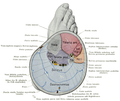Calf (leg)
Calf (leg)[edit]

The calf is the back portion of the lower leg in human anatomy. It is primarily composed of the gastrocnemius and soleus muscles, which together are known as the triceps surae. These muscles are responsible for plantar flexion of the foot at the ankle joint and play a crucial role in walking, running, and jumping.
Anatomy[edit]
The calf is located on the posterior side of the leg, below the knee and above the ankle. The main components of the calf include:
Muscles[edit]
- Gastrocnemius: This is the larger of the two calf muscles and has two heads that originate from the femur. It is visible beneath the skin and gives the calf its characteristic shape.
- Soleus: Located beneath the gastrocnemius, the soleus is a flatter and broader muscle that originates from the tibia and fibula.
Tendons[edit]
- Achilles tendon: This is the tendon that connects the calf muscles to the calcaneus (heel bone). It is the strongest and thickest tendon in the human body.
Function[edit]
The primary function of the calf muscles is to facilitate movement of the foot and ankle. The gastrocnemius and soleus work together to perform plantar flexion, which is the movement that allows you to stand on your toes. This action is essential for various activities such as walking, running, and jumping.
Clinical significance[edit]
The calf is a common site for muscle cramps, which can occur due to dehydration, overuse, or electrolyte imbalances. Additionally, the calf muscles can be strained or torn during physical activities, leading to pain and swelling.
The Achilles tendon is also prone to injuries such as tendinitis or rupture, especially in athletes and active individuals.
Related pages[edit]
Calf (leg)[edit]
Ad. Transform your life with W8MD's Budget GLP-1 injections from $75


W8MD offers a medical weight loss program to lose weight in Philadelphia. Our physician-supervised medical weight loss provides:
- Weight loss injections in NYC (generic and brand names):
- Zepbound / Mounjaro, Wegovy / Ozempic, Saxenda
- Most insurances accepted or discounted self-pay rates. We will obtain insurance prior authorizations if needed.
- Generic GLP1 weight loss injections from $75 for the starting dose.
- Also offer prescription weight loss medications including Phentermine, Qsymia, Diethylpropion, Contrave etc.
NYC weight loss doctor appointmentsNYC weight loss doctor appointments
Start your NYC weight loss journey today at our NYC medical weight loss and Philadelphia medical weight loss clinics.
- Call 718-946-5500 to lose weight in NYC or for medical weight loss in Philadelphia 215-676-2334.
- Tags:NYC medical weight loss, Philadelphia lose weight Zepbound NYC, Budget GLP1 weight loss injections, Wegovy Philadelphia, Wegovy NYC, Philadelphia medical weight loss, Brookly weight loss and Wegovy NYC
|
WikiMD's Wellness Encyclopedia |
| Let Food Be Thy Medicine Medicine Thy Food - Hippocrates |
Medical Disclaimer: WikiMD is not a substitute for professional medical advice. The information on WikiMD is provided as an information resource only, may be incorrect, outdated or misleading, and is not to be used or relied on for any diagnostic or treatment purposes. Please consult your health care provider before making any healthcare decisions or for guidance about a specific medical condition. WikiMD expressly disclaims responsibility, and shall have no liability, for any damages, loss, injury, or liability whatsoever suffered as a result of your reliance on the information contained in this site. By visiting this site you agree to the foregoing terms and conditions, which may from time to time be changed or supplemented by WikiMD. If you do not agree to the foregoing terms and conditions, you should not enter or use this site. See full disclaimer.
Credits:Most images are courtesy of Wikimedia commons, and templates, categories Wikipedia, licensed under CC BY SA or similar.
Translate this page: - East Asian
中文,
日本,
한국어,
South Asian
हिन्दी,
தமிழ்,
తెలుగు,
Urdu,
ಕನ್ನಡ,
Southeast Asian
Indonesian,
Vietnamese,
Thai,
မြန်မာဘာသာ,
বাংলা
European
español,
Deutsch,
français,
Greek,
português do Brasil,
polski,
română,
русский,
Nederlands,
norsk,
svenska,
suomi,
Italian
Middle Eastern & African
عربى,
Turkish,
Persian,
Hebrew,
Afrikaans,
isiZulu,
Kiswahili,
Other
Bulgarian,
Hungarian,
Czech,
Swedish,
മലയാളം,
मराठी,
ਪੰਜਾਬੀ,
ગુજરાતી,
Portuguese,
Ukrainian

